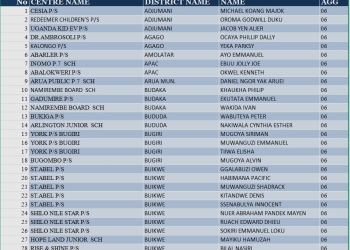KAMPALA, Uganda— Ugandan President Yoweri Kaguta Museveni delivered the State of the Nation Address on June 5, 2025, at the Kololo Ceremonial Grounds, outlining significant economic advancements, robust security measures, and ambitious development plans aimed at propelling the nation towards modernity and prosperity.
Museveni highlighted Uganda’s economic resilience, reporting that the economy is projected to reach Shs. 224.9 trillion (USD 60.4 billion) by the end of June 2025, marking nearly a 15-fold increase in dollar terms since the National Resistance Movement (NRM) government assumed power in January 1986. The economy grew by 6.7% in the first quarter of the current financial year, with a projected growth rate of 6.3% for the full financial year and 7.0% for fiscal year 2025/26. Faster growth is anticipated once commercial oil and gas production commences next year.
Uganda was recently ranked seventh globally among the fastest-growing economies by the International Monetary Fund (IMF). The president noted that the share of Ugandans living below the national poverty line has fallen to 16% from 20% four years ago, surpassing the 2025 national target of 18.5%. Other key socio-economic indicators show improvement, including an increase in life expectancy to 63 years from 45 years in 1986, and a rise in the literacy rate from 43% in 1986 to 80% today. The Ugandan shilling remains the most stable currency in Africa, having appreciated by 6.1% over the past 12 months, with inflation under control and projected at 3.6% for FY 2024/25, ranking as Africa’s second lowest in the past decade.
Foreign Direct Investment (FDI) inflows are projected at USD 3.8 billion, and tourism receipts reached USD 1.473 billion in calendar year 2024, a significant recovery from the 2020 COVID-19 shutdown.
Domestic revenue collection is projected at Shs. 31.9 trillion for the current financial year ending June 2025, with a target of Shs. 37.2 trillion for the next financial year. The government has injected over Shs. 8.03 trillion into strategic wealth creation initiatives over the last decade, including the capitalization of Uganda Development Bank, the Parish Development Model (PDM), Emyooga, and the Youth Livelihood Programme.
On peace and security, Museveni affirmed that the general situation in the country is calm despite ongoing threats like terrorism, negative political activism, and cross-border crime. He reported enhanced capacity of national security agencies, including the Uganda Police Force, Internal Security Organization, and the Uganda People’s Defence Forces (UPDF), to combat crime and ensure citizen safety.
Joint FARDC-UPDF operations against the Allied Democratic Forces (ADF) in Eastern Democratic Republic of Congo have seen significant achievements, with 223 abductees rescued since November 2024.
The president outlined four anchor sectors critical to increasing the economy tenfold to USD 500 billion by 2040: agro-industrialization, tourism development, mineral development (including oil and gas), and Science, Technology, and Innovation (STI).
In agro-industrialization, irrigation efforts have expanded, with 92 solar-powered schemes completed, adding 900 acres of irrigated land and benefiting 111,600 farmers. Dairy production reached 5.4 billion liters in 2024, and milk product exports increased tenfold to USD 285.4 million in 2024. Fish production stands at 658,000 tons annually, with exports increasing to USD 152.8 million.
Coffee production surged to 8.2 million 60kg bags in FY 2023/24, with exports valued at USD 1,144 million. The Parish Development Model, now in its third year, has seen Shs. 3.3 trillion provided, with Shs. 100 million allocated to each parish annually.
For mineral development, Uganda has ceased exporting unprocessed minerals to promote value addition.
The country now boasts 10 gold refineries producing 99.9% pure gold, and significant strides have been made in cement and steel production. The Uganda National Mining Company is being capitalized with UGX 500 billion over five years to take up to a 15% equity stake in strategic mining operations.
In the oil and gas sector, the East African Crude Oil Pipeline (EACOP) construction is nearing completion, and the Uganda National Oil Company’s bulk petroleum trading initiative has led to reduced fuel pump prices.
Science, Technology, and Innovation (STI) are also a key focus. The Kiira Vehicle Plant in Jinja is producing buses, with a secured market in West Africa for 3,700 electric buses.
Dei Biopharma in Matugga has filed over 100 patents, including for cancer treatment and various vaccines.
Ugandan scientists at Makerere University developed a PCR kit saving the country USD 37 million annually in imports. The Presidential Initiative on Banana Industrial Development (PIBID) plant has increased production and secured international orders.
Regarding infrastructure development, Museveni stated that the stock of tarmac roads has grown to 6,199 kilometers from 1,900 kilometers in 1986, with efforts focused on roads, railways, and electricity to support industrial growth.
Museveni emphasized the NRM’s “mass line” philosophy, aimed at guaranteeing the social uplift of all segments of society, not just the elite. He likened the NRM to a “wise builder” for establishing a strong foundation to propel Uganda to modernity, based on the principles of patriotism, Pan-Africanism, socio-economic transformation, and democracy.
While significant progress has been made, challenges remain, such as ensuring that the remaining 33% of households practicing subsistence agriculture join the money economy, and addressing laxity in implementing livestock quarantines.
The government aims to boost domestic revenue collection further to adequately finance its development programs.














